Texte Elisa Seydi – Photo DR –
Photo @ Taschen DR
Journaliste, mais travaillant aussi dans l’industrie musicale durant les années 90, Vikki Tobak fut le témoin de l’ascension des artistes de rap et de leur appétence pour les bijoux. Après Contact High : une histoire visuelle du Hip Hop, elle revient avec un livre qui retrace ce phénomène culturel ou le Hip Hop rencontre la bijouterie, en redéfinissant au passage les standards de la mode. Interview
Qu’est ce qui t’as motivé à réaliser un livre dédié au phénomène Bling Bling dans la culture Hip Hop ?
Lorsque j’étais en train de faire mon dernier livre Contatct High, Une histoire visuelle du Hip Hop, qui est une plongée dans la photographie Hip Hop, j’ai réalisé à quel point l’attitude, [mepr-show rules=”8316″ unauth=”message”] ainsi que le milieu de la mode était un art important de cette culture. Je me suis aussi rendu compte combien les bijoux tenaient une part importante dans cet environnement du fait qu’ils permettaient d’assoir une identité. Je savais qu’il y avait matière à raconter une histoire qui devait être révélée. L’art des ornements est-une part importante de l’histoire humaine, cela touche notre besoin profonde d’être vu ou de se mettre en valeur.
Pourquoi as-tu été attirée par le Hip Hop ?
Personnellement, je suis tombée amoureuse du Hip Hop, notamment parce que j’ai grandi à Détroit dans les années 80 en tant qu’immigrée, et aussi parce que j’ai travaillé dans le journalisme et l’industrie de la musique. Cela m’a notamment permis d’être à l’avant poste pour voir l’intéraction entre artiste et bijoux. Jay-Z venait tout juste d’avoir un signature unique chez Payday Records où je travaillais, mais on pouvait déjà sentir qu’il était destiné à une carrière grandiose, que ce soit musicalement ou au niveau de son style. C’était le début des années 90, et l’univers des bijoux Hip Hop était encore dominé par l’or et son antithèse, à savoir les médaillons africains ou les perles en bois arborer par De La Soul ou Public Enemy. Mos était plus dans ce camp. A cette époque, la vente de bijoux dans le quartier de Canal Street était importante. Je me rappelle que Guru, de GangStarr, avec qui je travaillais, y avait acheté son pendentif en or représentant une couronne, un bijou similaire à celui que Big Daddy Kane. Quand Jay-Z et Diddy ont commencé à porter de l’or platine ainsi que des diamants quelques années plus tard, il y a eu un changement radical, et les enjeux sont devenus plus grands.

Comment as-tu choisi les photos ainsi que les photographes qui figurent dans le livre ?
Il y a certains rappeurs dont la présence était incontournable du fait de leur implication dans le monde des bijoux Hip Hop. Il y avait aussi des bijoutiers comme Tito Caicedo, Jacob Arabo “Jacob the Jeweler”, Eddie Plain, Avianne, Eliantte, Ben Baller, Greg Yuna. On ne pouvait pas non plus faire l’impasse sur certains artistes Hip Hop comme LL Cool J, dont la bague avec son nom, a contribué à sa popularité. Sans oublier Biz Markie’s et ses chaines à maillons torsadées, Cam’ron et son pendentif coulissant en forme de planète terre, le pendentif de Roc A Fella Records etc… L’art des ornements fait partie de notre histoire humaine commune. Elle témoigne de notre envie viscérale de se montrer et d’être vu. Je suis parti de ce constat pour réunir les éléments qui constituent ce livre. Le Hip Hop est une culture du remix et de la customisation que je voulais célébrer à travers ce livre. Comme Taschen, à des standards élevés en terme de photo, il fallait vraiment des photos et des artistes capables de raconter cette histoire de manière très esthétique. Je voulais aussi m’assurer de montrer l’évolution du style des bijoux Hip Hop. On est passé de la simple chaine en or à la grosse chaine torsade, puis aux maillons cubains ainsi qu’aux pendentifs spécifiques, notamment celui de Kanye West, une tête de Jésus, désignée par Murakami
Quel est le prix de certains des bijoux que l’on peut voir dans le livre ?
Cela va des chaines en or plutôt bon marché que l’on trouvait au début à des bijoux qui coutent maintenant des millions de dollars. On peut vraiment constater l’évolution financière du Hip Hop, à partir du moment où il a généré plus d’argent, des matériaux comme le diamant et l’or platine ont fait leur apparition. Désormais, la seule limite, c’est le ciel !
Cela à commencer avec de l’or, et maintenant ce sont des diamants.A quoi s’attendre dans le futur ?
Il y a plusieurs étapes importantes dans le domaine des bijoux Hip Hop. On a commencé au début avec une culture de rue à laquelle les rappeurs appartenaient, puis les artistes Hip Hop ont commencé à élever le niveau grâce à des artistes comme Big Daddy Kane, Rakim, Biz Markie, ou Roxanne Shanté, qui arboraient des bijoux en or assez volumineux. Puis, Jay Z and Diddy, ont introduit le platine ainsi que les diamants. En parallèle, il y a eu la montée en force des dentiers en or, diamants ou platine, avec des pionniers comme Eddie Plein. Quand des artistes comme Pharrell ont commencé à utiliser des diamants de couleurs en collaborant avec Jacob “The Jeweler”, cela a eu pour effet d’ouvrir une porte pour les expérimentations de matériaux et de design. On a vu l’apparition de l’émail, ou de système coulissant pour mettre en valeur un pendentif, sans oublier la culture des dessins animés. Puis on a vu des artistes comme Gucci Mane arriver en propulsant l’univers des bijoux Hip Hop à un autre niveau et la montée en force de la scène d’Atlanta ainsi que du Sud. Cette culture est incroyable et en perpétuelle gestation. Dernièrement, j’ai été extrêmement heureuse de voir la montée en force des rappeuses dans l’univers des bijoux, tout spécialement dans le domaine des montres. Les collections de Kash Doll, Megan Thee Stallion, Latto ou Cardi B’s sont incroyables et représentatives d’une forme de pouvoir à travers les bijoux. J’ai vraiment l’impression que tout est possible et je regarde avec attention comment le Hip Hop continue à influencé le marché du luxe. Cette culture a désormais atteint un niveau ou elle à un gros impact sur le marché du luxe. Vous avez désormais des marques comme Tiffany & Co, Cartier ou des marques de montre comme Audemars Piguet ou Patek Philippe, qui embrasse la culture Hip Hop à travers le pouvoir de ses stars mais aussi pour l’influence de son style. Quand on regarde la dernière collection de Tiffany & Co, on retrouve certains éléments du Hip Hop dans le style et l’inspiration. C’est en tout cas une belle histoire de voir cette culture redéfinir le style, alors qu’à la base, elle vient de rien. De pouvoir assister à la montée en force, la prospérité, et l’impact d’une génération dans le monde mainstream.
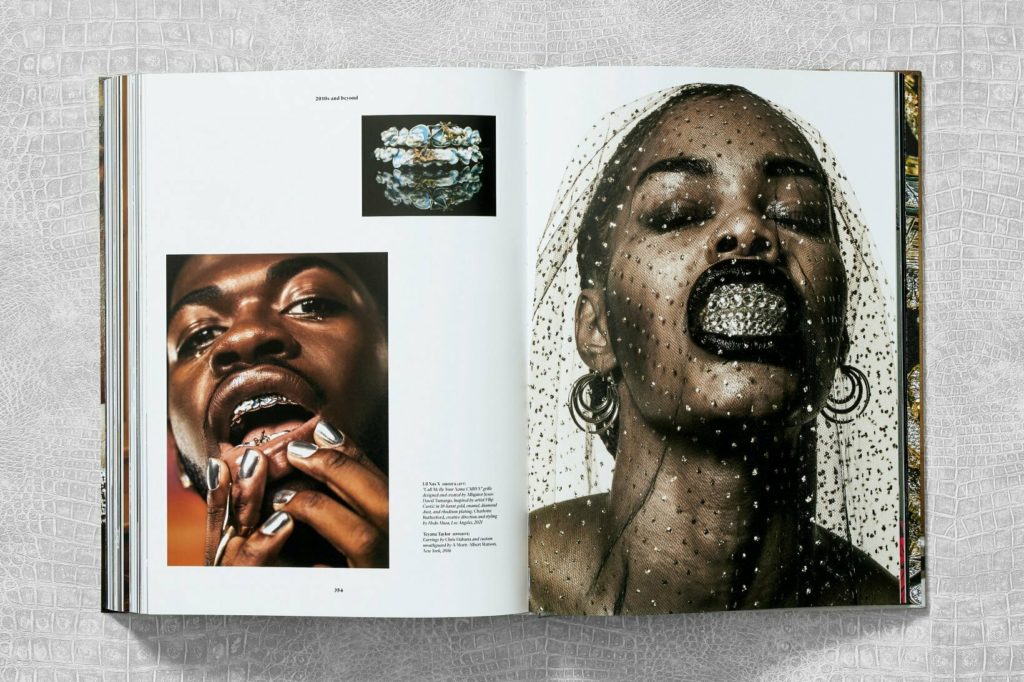
Pourquoi les bijoux sont devenus si populaires dans le Hip Hop et auprès des artistes rap ?
Avec les bijoux Hip Hop, il est presque impossible de séparer les germes de ce mouvement avec des enjeux plus importants que sont la politique, l’identité, la race, ainsi que la complexité de l’histoire. C’est à partir de ce constant que j’ai voulu créer les fondations de ce livre. Annoncer la couleur de cette culture. L’esthétique afro et les connotations historiques sont vraiment très importantes. Quand le Hip Hop est devenu un pouvoir montant au début des années 90, ainsi qu’une industrie florissante, les bijoux ont alors représenté des aspirations plus grandes ainsi que des budgets en hausse. On a commencé à voir l’apparition du platine, des diamants à partir du moment ou l’argent à circuler beaucoup plus facilement. On aussi commencé à entendre des noms de bijoutiers dans les lyrics des rappeurs. La chose que j’ai trouvé très intéressante et surprenante, c’est la proximité que le Hip Hop partage avec les bijoutiers qui ont travaillé avec les rappeurs. La plupart des bijoutiers sont immigrés, ou fils d’immigrés, alors ils comprennent le langage de la débrouille, l’esprit de transcendance, et les aspirations de rappeurs. Avoir un style de vie confortable, construite une notoriété et créer une communauté, sont des notions que partagent le Hip Hop avec la culture des immigrants. Les acteurs de la bijouterie, même encore à ce jour, sont pour la plupart immigrés ou fils d’immigrés. Des bijoutiers comme Ben Baller, Johnny Dang, Jacob The Jeweler, Tito Eliantte, Greg Yuna par exemple. J’adore cette partie de l’histoire, car elle porte une réflexion sur le rêve américain et ceux qui le vivent.
Quelle a été la réaction des artistes quand le livre est sorti ?
Ils sont ravis de voir qu’ils figurent dans un livre qui couvre plus de 50 ans et ont conscience de la place qu’ils occupent dans cette histoire continue. Des artistes plus jeunes comme ASAP Rocky ou Tyler the creator, ont tous les deux manifesté combien ils aimaient ce livre et même les membres de la vieille école plus impliqués dans la bijouterie de rue, m’ont confié combien ils appréciaient le fait que l’ouvrage commence chronologiquement par leur histoire.
Quel est selon toi, le top 3 des meilleurs détenteurs de bijoux Hip Hop de tous les temps ?
Je dirais que les pendentifs à tête de Jésus de Biggie sont un moment important car ils ont été conçus par Tito Caicedo, un fameux bijoutier, et aussi parce que cela a popularisé ce type de pendentifs qui est devenu une véritable tendance dans le Hip Hop. Au point que plusieurs années après, Kanye West s’est fait créer une tête de Jesus par Murakami, et Lil Yachty, un Yachty Jesus. Biggie n’a pas été le seul (Lord Finess portait la tête de Jesus avant, tout comme des individus comme Jesus de Brooklyn ou Rapp du crew de Rakimp) mais il a amené ce bijoux à un autre niveau. Les collections de Pharrell Williams et Gucci Mane avec leurs bijoux sertis de diamants multicolores en référence aux bandes dessinées, ont aussi ouvert la voie à de nombreuses expérimentations dans le domaine des bijoux Hip Hop. Tyler The Creator figure aussi parmi cette liste par rapport à ce qu’il fait actuellement.
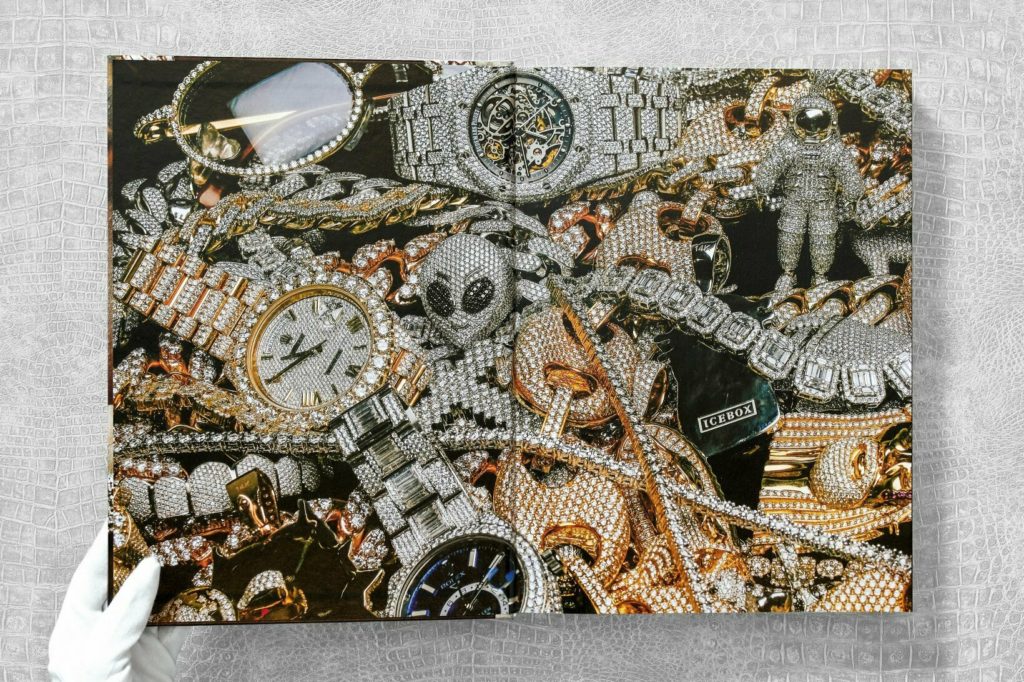
Selon toi, comment les bijoux Hip Hop ont influencé la société ?
Avec le Hip Hop, l’histoire des bijoux a tissé des liens avec la création musicale. Le Hip Hop est une culture du remix et de la customisation. C’est vraiment cet aspect que je voulais célébrer dans ce livre. Taschen, l’éditeur, à un tel niveau d’exigence en terme de photos, qu’il fallait vraiment que ces dernières captures l’histoire des artistes, dans un style très esthétique. Les bijoux Hip Hop reflètent quelque chose de bien plus profond qu’une simple représentation visuelle instantanée. Je voulais célébrer cette profondeur, pas juste le coté flashy. Le style est un dialogue visuel. Le Hip Hop a repris à son compte ce dialogue avec une vision plus claire, associé à l’histoire de la diaspora noire, ce qui a accentué sa domination globale, son charisme, et cela sans complexe, avec une touche street avisée. Les artistes utilisent les bijoux pour exprimer leur individualité, leur identité. Ils font aussi allégeance à leurs quartiers, groupes, labels, copains d’enfances, etc.. Avec les bijoux Hip Hop, il est presque impossible de séparer les germes de cet univers aux enjeux politiques, identitaires, ou de race, sans oublier la complexité historique de ce mouvement. Je voulais le service de ces bases pour raconter mon récit. Annoncer la couleur de cette culture de rue. L’esthétique africaine, et les connotations artistiques sont très importantes. A partir de là, je voulais célébrer les artistes qui s’expriment à travers leurs bijoux. Célébrer la culture underground des bijoux Hip Hop et son ascension en parallèle à sa prise de pouvoir. Maintenant que le Hip Hop croise son chemin régulièrement avec le luxe, il y a un besoin encore plus fort de découvrir cette histoire cachée et comment cette culture est parvenue pas à pas à être aussi puissante.
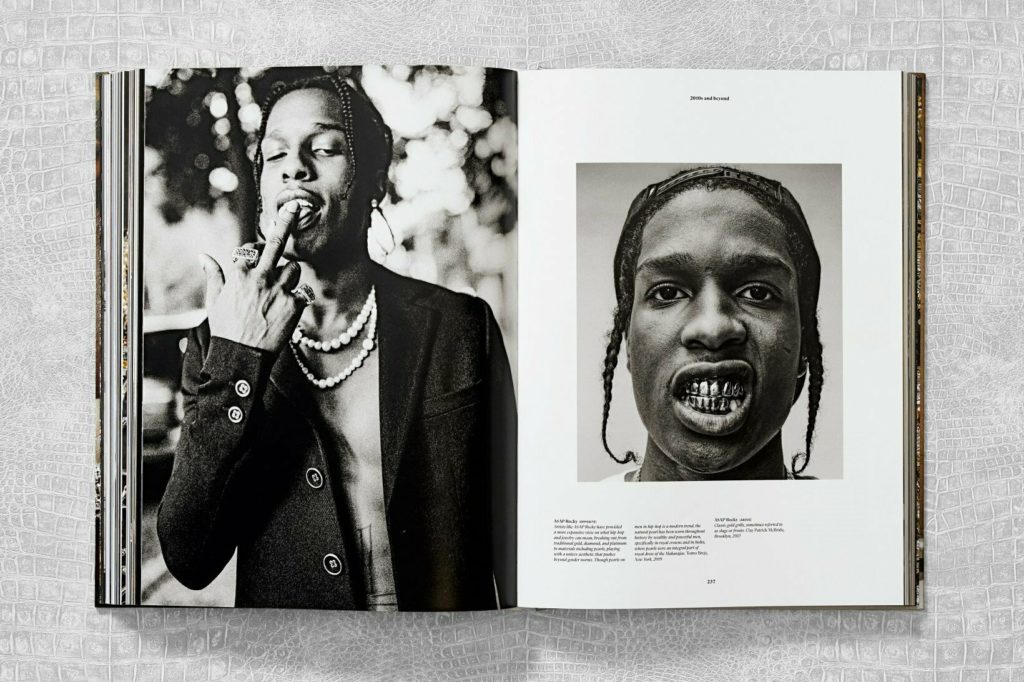
Quelques anecdotes amusantes durant la réalisation de ce livre ?
Je ne dirais pas amusantes, mais plutôt surprenantes. J’ai été très surprise de voir que beaucoup d’artistes n’avaient pas conservé leurs bijoux. Au delà de ça, ce que j’ai trouvé très intéressant et surprenant, c’est la connexion intellectuelle entre le Hip Hop et les bijoutiers qui travaillent avec les rappeurs. La plupart des bijoutiers sont des immigrés, ou fils d’immigrés, alors ils comprennent le langage de la débrouille, l’envie de se transcender, et les aspirations à voir plus haut. Les notions qui sont autour de la réussite, la communauté, la reconnaissance, sont une culture que le Hip Hop et les immigrés partagent en commun. Je parle bien entendu des bijoutiers qui évoluent dans cette culture comme Ben Baller, Johnny Dang, Jacob the Jeweler, Tito, Eliantte, Greg Yuna. Tous ces noms connus et reconnus sont pour la plupart des fils d’immigrés ou des immigrés eux même. J’adore cet aspect de cette histoire, car cela met en perspective et question, le rêve américain, et ceux qui le font vivre.
English
As a journalist, but also working in the music industry during the 90s, Vikki Tobak witnessed the rise of rap artists and their appetite for jewelry. After Contact High: A Visual History of Hip Hop, she returns with a book that traces this cultural phenomenon where Hip Hop meets jewelry, redefining fashion standards in the process.
What was the impulse to do this book dedicate to the bling and Jewelry?
When I was doing my last book, Contact High: A Visual History of Hip-Hop (a deep dive into hip-hop photography), I noticed how ways of dressing and posing along with sneaker culture and the politics of fashion were an important part of the culture. I also started noticing how jewelry was used as this communication tool and a way to assert identity and knew there was a much bigger story here that needed to be told. The art of adornment is part of our shared human history and taps into our deep need to show up and show out.
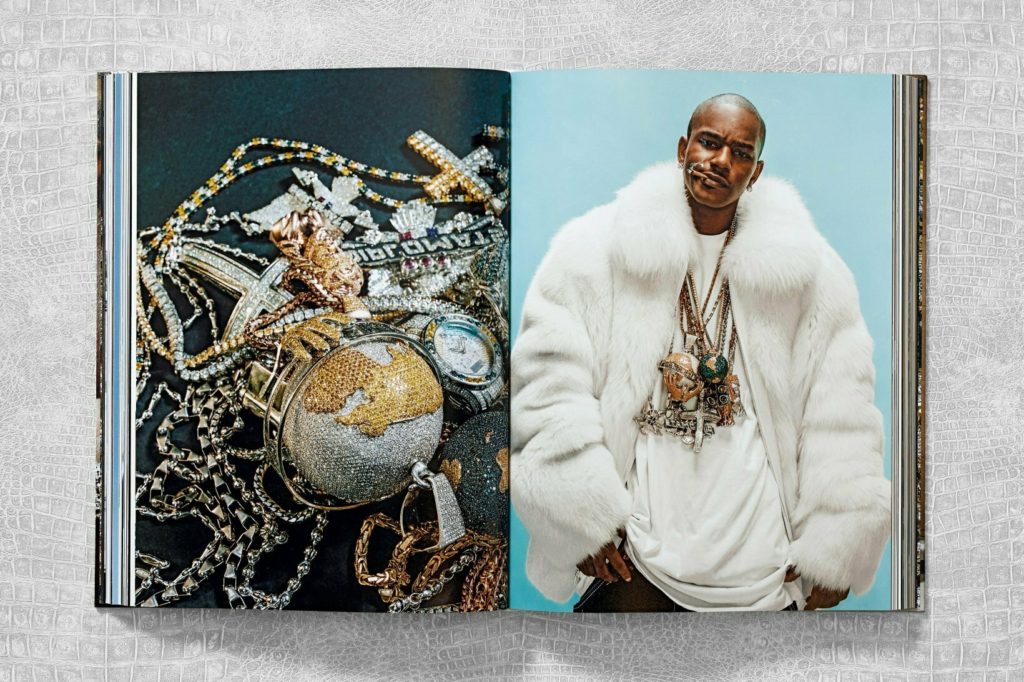
Why the Jewelry In Hip Hop attracted you ?
Personally, i fell in love with hip-hop as an immigrant kid growing up in Detroit of the 1980’s and then went on to work in the music business and then journalism. I got to witness firsthand how hip-hop artists interacted with jewelry. Jay-Z was just signed to a singles deal at Payday Records where I worked but you could already see he was destined for greatness but musically and sartorially. This was the early 90’s so the hip-hop jewelry world was still either big gold or the antithesis of that which was the beads and leather Afrocentric medallions that De La Soul and a public Enemy wore. Mos was more in that camp. The Canal Street gold scene was also big at the time and I recall Guru from GangStarr who I worked with got this gold crown pendant which looked similar to one Big Daddy Kane had. When Jay and Diddy got into diamonds and platinum just a short time later everything changed and the stakes got bigger.
What was the process of choosing the photographer and the pictures ?
There were certain rappers and certain jewelers who evolved the hip-hop jewelry world so they had to be included. Jewelers like Tito Caicedo, Jacob the Jeweler, Eddie Plein, Avianne, Eliantte, Ben Baller, Greg Yuna..and then of course hip-hop artist who were known for certain pieces like LL Cool J with his nameplate ring, Biz Markie’s dookie ropes, Cam’ron with his spinning globe, The Roc chain etc…
The art of adornment is part of our shared human history and taps into our deep need to show up and show out. I started from there in thinking about the curation for this book. Hip-hop is a culture of remixing and customization and I really wanted to celebrate that in this book. And because Taschen has such a high bar for photography, we had to make the photography captured the story and the artists in a very beautiful way.
I also wanted to make sure to show the evolution of the jewelry styles from simple gold to bigger gold to dookie ropes to Cuban links to specific pendants like Kanye’s Murakami Jesus piece and on and on….
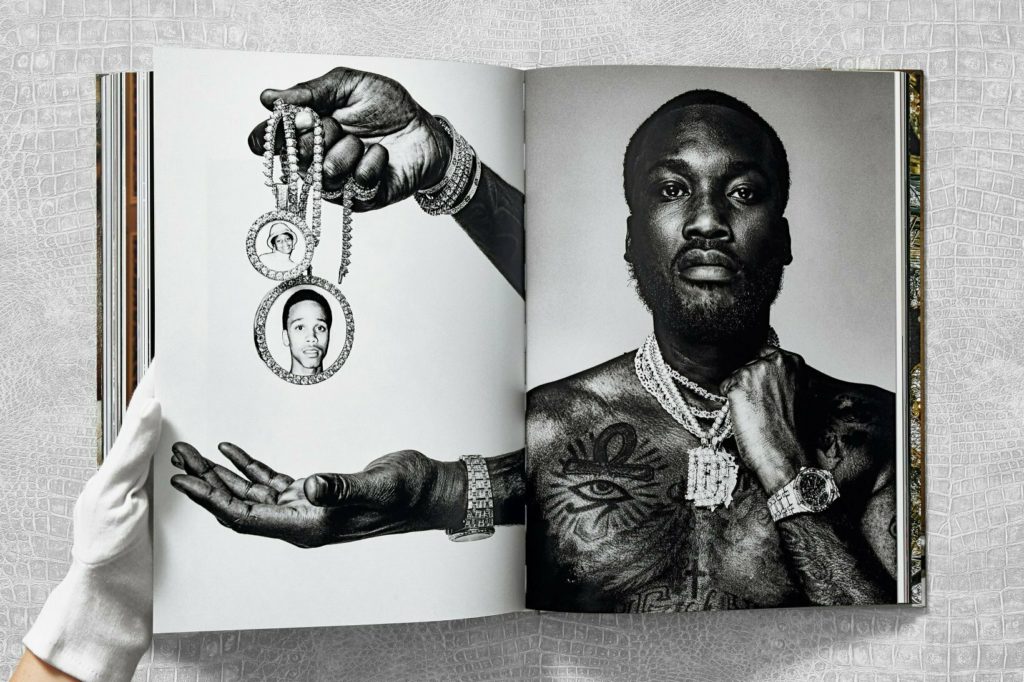
How much cost some of the jewelry feature on the book?
It ranges from pretty inexpensive with the early more modest simple gold chains on upwards to the millions today. You can really see the progression as hip-hop started to get money and the materials started expanding into diamonds and platinum. Today sky is really the limit.
Why it became so popular for the Hip Hop and The Rap Artist?
With hip-hop jewelry, it’s almost impossible to separate the gemstones from the bigger narrative of politics, identity and race, and historical complexity. That’s where I wanted to start as the foundation for this story. Setting the tone of street culture, African aesthetics and the historical connotations were really important.
When hip-hop really stepped into its power in the early 90’s and became a full-fledged industry, the jewelry reflected the bigger budgets and bigger aspirations. You started to see platinum and diamonds being used as the money flowed more freely and you started hearing the jewelers name dropped in song lyrics. The thing that I also found really interesting and surprising is the shared mentality of hip-hop and the jewelers who work with hip-hop artists. Most of the jewelers are either Immigrants or kids of immigrants so they understand the language of hustle, transcendence and aspiration. The notions around building wealth, building a legacy, building a community are all things hip-hop and immigrant culture has in common. The people behind the jewelry even to this day—Ben Baller, Johnny Dang, Jacob the Jeweler, Tito, Eliantte, Greg Yuna —all household names of the culture—are also largely immigrants or the children of immigrants. I love that part of the story because it speaks to questions around the American Dream and who it’s for.
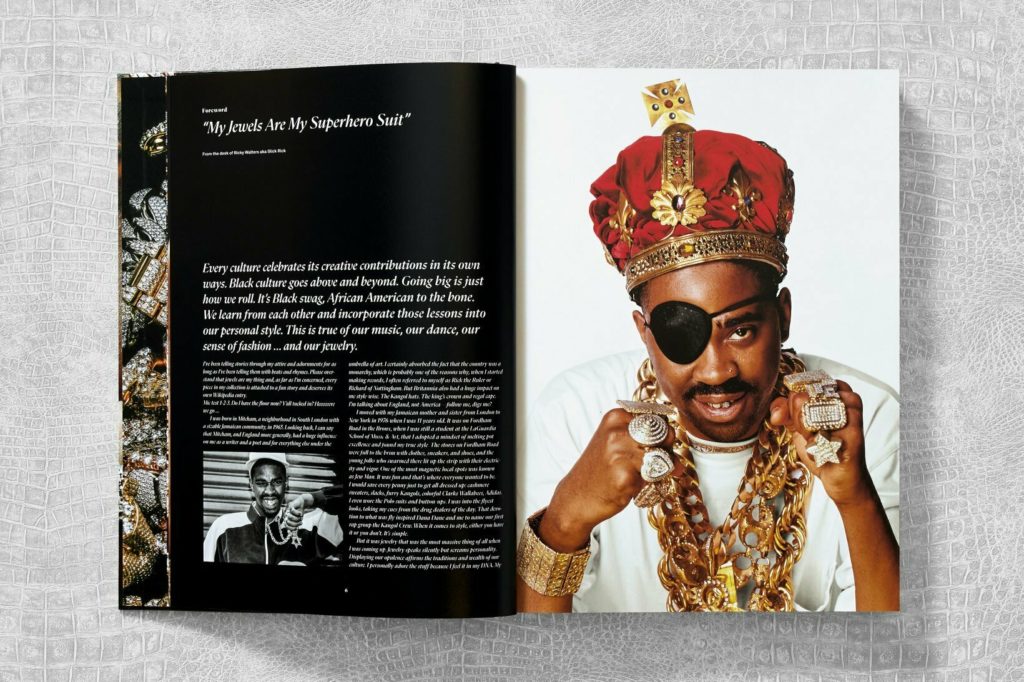
What was the reaction of the artiste when the book was release?
The artists are thrilled to be in one book that spans almost 50 years and understand their place in that historical continuum. The younger guys like ASAP Rocky and Tyler have both shared how much they love the book and even the old school folks who were more involved in the street side of things have told me how much they appreciate that I started the book there.
Who are in your opinion the top 3 hip hop jewelery owner of all times?
I would say Biggie’s Jesus pieces were an early important moment as they were made by the famous jeweler Tito Caicedo and set off the Jesus piece trend in hip-hop where later you see Kanye creating Murakami Jesus and then Lil Yachty creating a Yachty Jeus and so on. Biggie wasn’t the first (Lord Finesse wore it earlier and also street dudes like Jesus from Brooklyn and Rapp from Rakim’s crew). But Biggie took it to another level.
Also Pharrell and Gucci Mane’s collections with the use of multi colored stones and cartoon/anime themes really opened the door for more expérimentation in hip-hop jewelry. I’ll also add Tyler, The Creator to that top list for someone who’s doing it big right now.
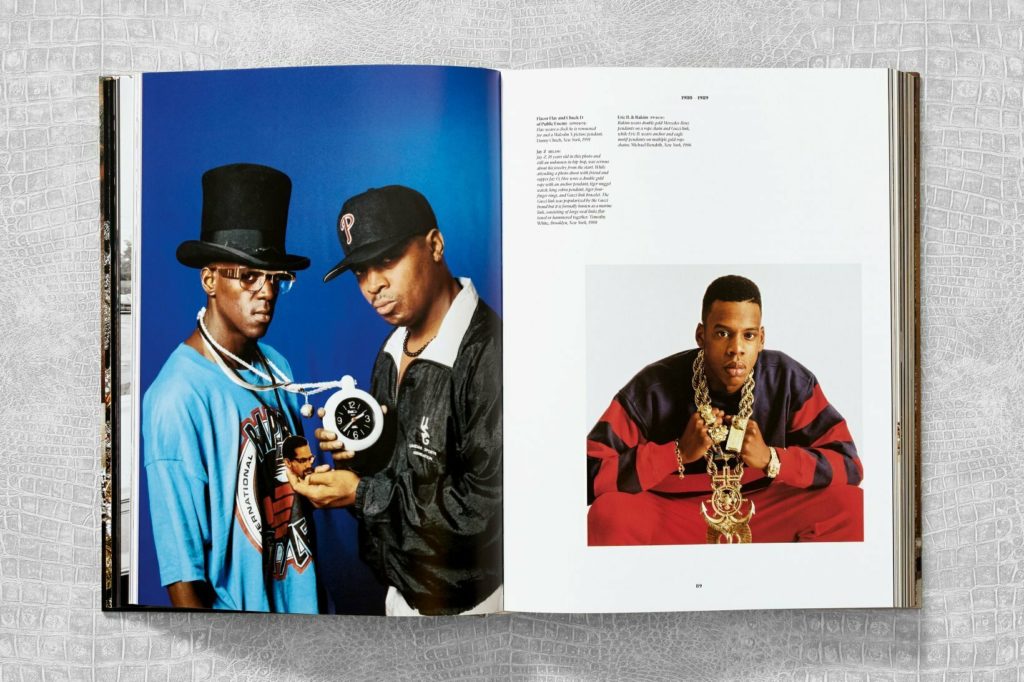
It started with gold and now its diamond.. What’s gona be next ?
There are so many milestone moments in the jewelry game: you start with the street culture that the rappers were looking to in the beginning, then as hip-hop artists started to ascend you had artists like BIg Daddy Kane, Rakim, Biz, Roxanne Shante wearing all the big gold truck style jewelry. Then Jay-Z and Diddy got hip-hop into platinum and diamonds alongside the rise of grills culture with early pioneers like Eddie Plein. When folks like Pharrell started using colored gems and collaborating with Jacob the Jeweler we saw a door open to more experimentation with materials such enamel and nods to anime and cartoon culture. Then you start to see Gucci Mane come in and elevate the jewelry game and the rise of the South/Atlanta jewelry movement. The culture is truly amazing and a continuum of sorts. Lately, I’ve been so happy to see the rise of women rappers collecting jewelry and especially watches – Kash Doll, Megan thee Stallion, Latto and Cardi B’s watch collection is amazing and the women are really stepping into their power with jewelry.
I really feel like now anything is possible and I’m watching to see how hip-hop continues to influence the luxury market. Hip-hop is now in a place in history where it is having a huge impact on the luxury market. You’re starting to see brands like Tiffany, Cartier and the watch brands like Audemars Piguet and Patek Phillipe really embrace hip-hop for its star power as well as its style influences. Even looking at Tiffany’s latest collections you can see éléments of hip-hop link styles and inspiration. It’s really quite a beautiful story of a culture that redefined style coming out of nothing and rising to build generational wealth and impact the mainstream world.
In your opinion how Hip Hop jewelry influence society?
With hip-hop, the history of the jewelry is woven into the fabric of the music. Hip-hop is a culture of remixing and customization and I really wanted to celebrate that in this book. And because Taschen has such a high bar for photography, we had to make the photography captured the story and the artists in a very beautiful way. Hip-hop jewelry is so much bigger than conspicuous consumption and I really wanted this book to celebrate something bigger than just bling. Style is a visual dialogue. Hip-hop took that dialogue and, with a clarity of vision and Black diasporic history, elevated all the way to global dominance—unapologetic, charismatic, and dripping in street savvy. Artists use jewelry to express their individuality, their identity, allegiance to neighborhoods, crews, brotherhoods, label affiliations etc…
With hip-hop jewelry, it’s almost impossible to separate the gemstones from the bigger narrative of politics, identity and race, and historical complexity. That’s where I wanted to start as the foundation for this story. Setting the tone of street culture, African aesthetics and the historical connotations were important. From there, we celebrate the artists who so beautifully express themselves through jewelry and the jewelry subculture that emerged as hip-hop was rising to power. And with hip-hop’s intersection with luxury goods now a given, there’s an even deeper story to be told of how the culture stepped into its power.

Anny funny thing about the process of doing this book?
I wouldn’t say anything funny but definitely surprising. I was surprised by how many early artists don’t have their pieces anymore. But beyond that, thing that I found really interesting and surprising is the shared mentality of hip-hop and the jewelers who work with hip-hop artists. Most of the jewelers are either Immigrants or kids of immigrants so they understand the language of hustle, transcendence and aspiration. The notions around building wealth, building a legacy, building a community are all things hip-hop and immigrant culture has in common. The people behind the jewelry even to this day—Ben Baller, Johnny Dang, Jacob the Jeweler, Tito, Eliantte, Greg Yuna —all household names of the culture—are also largely immigrants or the children of immigrants. I love that part of the story because it speaks to questions around the American Dream and who it’s for. [/mepr-show]
Ice Cold. A Hip-Hop Jewelry History 388 pages. € 80 Édition multilingue: allemand, anglais, français





Thanks for sharing. I read many of your blog posts, cool, your blog is very good.
Thanks for your words.
Best la Fashionerie